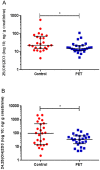Serum and urine vitamin D metabolite analysis in early preeclampsia
- PMID: 29217650
- PMCID: PMC5793806
- DOI: 10.1530/EC-17-0308
Serum and urine vitamin D metabolite analysis in early preeclampsia
Abstract
Vitamin D deficiency is common in pregnant women and may contribute to adverse events in pregnancy such as preeclampsia (PET). To date, studies of vitamin D and PET have focused primarily on serum concentrations vitamin D, 25-hydroxyvitamin D3 (25(OH)D3) later in pregnancy. The aim here was to determine whether a more comprehensive analysis of vitamin D metabolites earlier in pregnancy could provide predictors of PET. Using samples from the SCOPE pregnancy cohort, multiple vitamin D metabolites were quantified by liquid chromatography-tandem mass spectrometry in paired serum and urine prior to the onset of PET symptoms. Samples from 50 women at pregnancy week 15 were analysed, with 25 (50%) developing PET by the end of the pregnancy and 25 continuing with uncomplicated pregnancy. Paired serum and urine from non-pregnant women (n = 9) of reproductive age were also used as a control. Serum concentrations of 25(OH)D3, 25(OH)D2, 1,25(OH)2D3, 24,25(OH)2D3 and 3-epi-25(OH)D3 were measured and showed no significant difference between women with uncomplicated pregnancies and those developing PET. As previously reported, serum 1,25(OH)2D3 was higher in all pregnant women (in the second trimester), but serum 25(OH)D2 was also higher compared to non-pregnant women. In urine, 25(OH)D3 and 24,25(OH)2D3 were quantifiable, with both metabolites demonstrating significantly lower (P < 0.05) concentrations of both of these metabolites in those destined to develop PET. These data indicate that analysis of urinary metabolites provides an additional insight into vitamin D and the kidney, with lower urinary 25(OH)D3 and 24,25(OH)2D3 excretion being an early indicator of a predisposition towards developing PET.
Keywords: biomarker; preeclampsia; pregnancy; serum and urine; vitamin D.
© 2018 The authors.
Figures




Similar articles
-
Dysregulation of maternal and placental vitamin D metabolism in preeclampsia.Placenta. 2017 Feb;50:70-77. doi: 10.1016/j.placenta.2016.12.019. Epub 2016 Dec 18. Placenta. 2017. PMID: 28161064 Free PMC article.
-
Development and validation of the simultaneous measurement of four vitamin D metabolites in serum by LC-MS/MS for clinical laboratory applications.Anal Bioanal Chem. 2016 Nov;408(27):7617-7627. doi: 10.1007/s00216-016-9821-4. Epub 2016 Aug 15. Anal Bioanal Chem. 2016. PMID: 27526091
-
Development and application of a LC-MS/MS assay for simultaneous analysis of 25-hydroxyvitamin-D and 3-epi-25-hydroxyvitamin-D metabolites in canine serum.J Steroid Biochem Mol Biol. 2020 May;199:105598. doi: 10.1016/j.jsbmb.2020.105598. Epub 2020 Jan 17. J Steroid Biochem Mol Biol. 2020. PMID: 31958632
-
Iatrogenic vitamin D toxicity in an infant--a case report and review of literature.J Steroid Biochem Mol Biol. 2015 Apr;148:14-8. doi: 10.1016/j.jsbmb.2015.01.022. Epub 2015 Jan 27. J Steroid Biochem Mol Biol. 2015. PMID: 25636720 Review.
-
Vitamin D and pregnancy: the maternal-fetal metabolism of vitamin D.Endocr Rev. 1981 Summer;2(3):264-74. doi: 10.1210/edrv-2-3-264. Endocr Rev. 1981. PMID: 7023922 Review.
Cited by
-
The Relative Expression of ERα Isoforms ERα66 and ERα36 Controls the Cellular Response to 24R,25-Dihydroxyvitamin D3 in Breast Cancer.Mol Cancer Res. 2021 Jan;19(1):99-111. doi: 10.1158/1541-7786.MCR-20-0169. Epub 2020 Oct 20. Mol Cancer Res. 2021. PMID: 33082240 Free PMC article.
-
Defining vitamin D status using multi-metabolite mathematical modelling: A pregnancy perspective.J Steroid Biochem Mol Biol. 2019 Jun;190:152-160. doi: 10.1016/j.jsbmb.2019.03.024. Epub 2019 Mar 26. J Steroid Biochem Mol Biol. 2019. PMID: 30926429 Free PMC article.
-
Prediction of pregnancy-related hypertensive disorders using metabolomics: a systematic review.BMJ Open. 2022 Apr 25;12(4):e054697. doi: 10.1136/bmjopen-2021-054697. BMJ Open. 2022. PMID: 35470187 Free PMC article.
-
The Quantification of Vitamin D in Humans: A Promising, Non-Invasive and Cost-Effective Method to Measure 25-Hydroxyvitamin D.Biomolecules. 2025 Apr 10;15(4):560. doi: 10.3390/biom15040560. Biomolecules. 2025. PMID: 40305348 Free PMC article.
-
A Mathematical Model for Determining the Body's Fluctuating Need for and Synthesis of Active Vitamin D.Biomedicines. 2023 Jan 24;11(2):324. doi: 10.3390/biomedicines11020324. Biomedicines. 2023. PMID: 36830861 Free PMC article.
References
Grants and funding
LinkOut - more resources
Full Text Sources
Other Literature Sources
Research Materials

